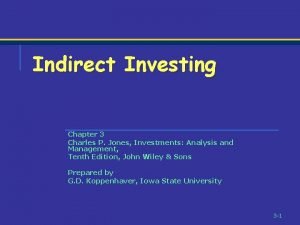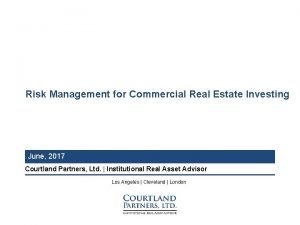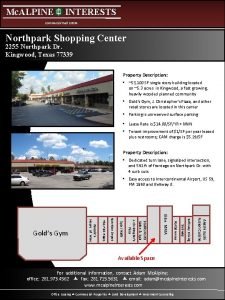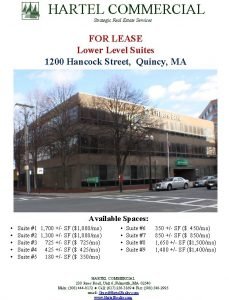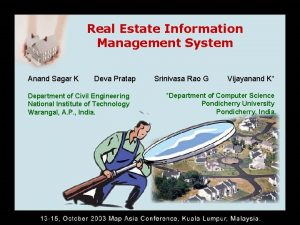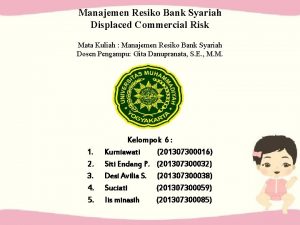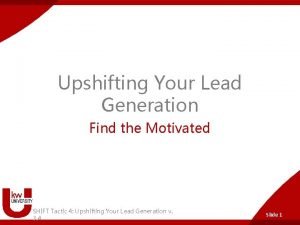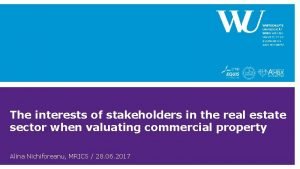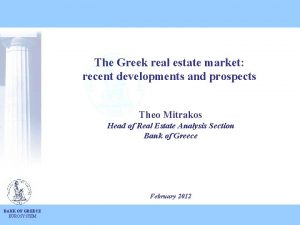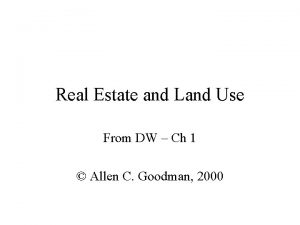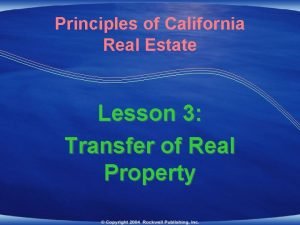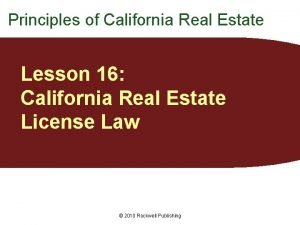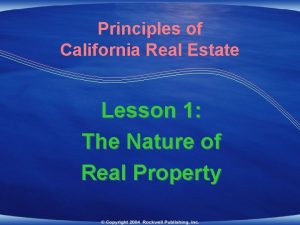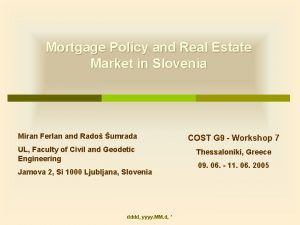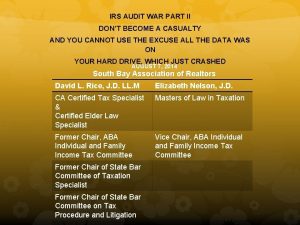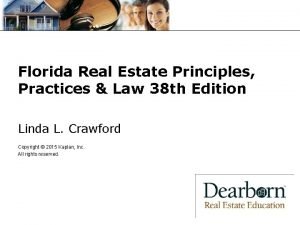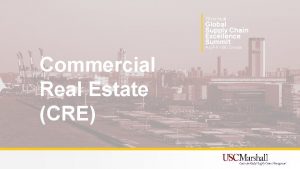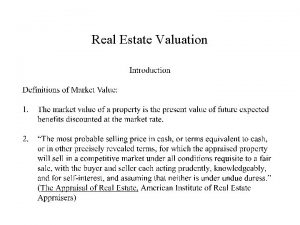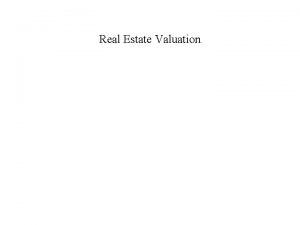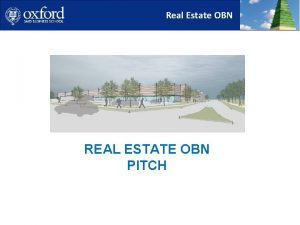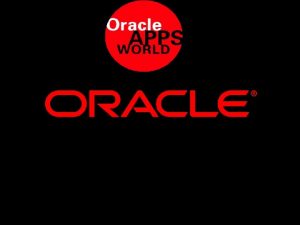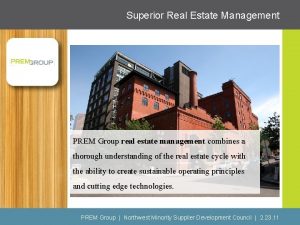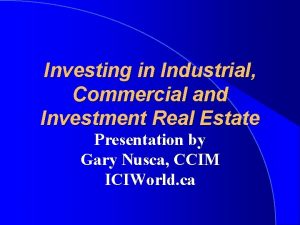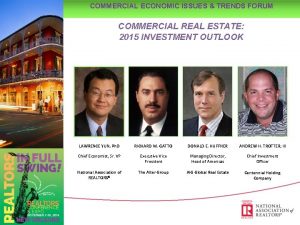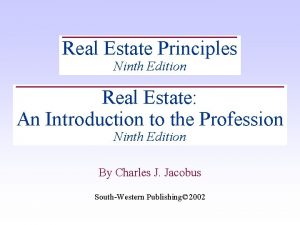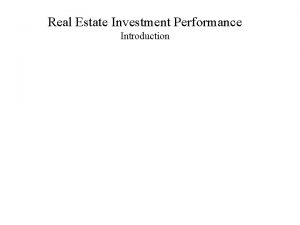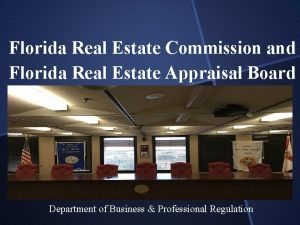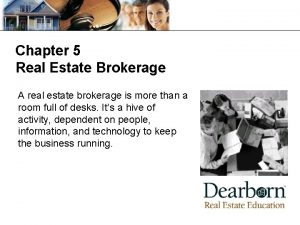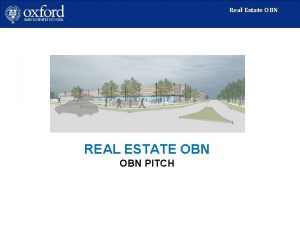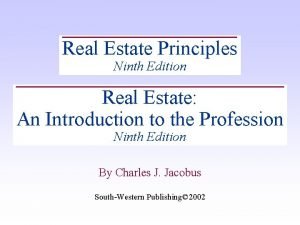Risk Management for Commercial Real Estate Investing June






























- Slides: 30

Risk Management for Commercial Real Estate Investing June, 2017 Courtland Partners, Ltd. | Institutional Real Asset Advisor Los Angeles | Cleveland | London

What is risk management? • • For our purposes risk management will be defined by the following characteristics: – Identifying drawdown risk – Quantifying drawdown risk – Managing drawdown risk To approach this for commercial real estate investors, we need to understand the factors that affect return for commercial real estate and how each of these factors can potentially impact a drawdown 2 Courtland Partners, Ltd.

Components of Real Estate Return • Shown below are the formulas that describe the relationship between total real estate return and the components of the return • We can then break cash flow down into its component parts of NOI and Capex CF = NOI – Capex • We can then restate each of these components as a percentage of the initial investment basis which will allow a calculation of the return as a percent of the investment basis k. RE asset = NOI Yield – Basis growth + NOI growth Source: Pagliari 3 Courtland Partners, Ltd.

Components of Real Estate Return To have this formula be relevant to an actual real estate investment, an asset management fee can be included which is stated as a fee as a percent of the equity invested • kunlevered RE fund gross of cap rate change= NOI Yield – Basis growth + NOI growth – Asset Management Fee Next we need to adopt the model to incorporate the use of financial leverage • klevered RE fund gross of cap rate change = (1 + leverage) * (NOI Yield – Basis growth + NOI growth) – (leverage * economic leverage cost) – Asset Management Fee • Finally we need to include a component to account for the change in cap rate which may be positive or negative klevered RE fund net of cap rate change = (1 + leverage) * (NOI Yield – Basis growth + NOI growth) – (leverage * economic leverage cost) + net effect of cap rate change – Asset Management Fee Source of Formulas: Pagliari 4 Courtland Partners, Ltd.

Components of Real Estate Return • • Components of Real Estate Return – NOI Yield – NOI Growth – Basis Growth – Leverage – Economic Leverage Cost – Asset Management Fee – Net Effect of Cap Rate Change We will look at each component and determine the sensitively of a potential drawdown to changes in each component 5 Courtland Partners, Ltd.

NOI Yield • • Looking at the return formula for real estate, we see that a change in NOI yield will have a linear effect on returns if there is no financial leverage – A 1% increase in NOI Yield will increase the fund return by 1% The use of financial leverage will exacerbate the effect of a change in NOI yield in a linear fashion – A 1% increase in NOI Yield on a 50% leveraged fund will increase the fund return by 1. 5% klevered RE fund net of cap rate change = (1 + leverage) * (NOI Yield – Basis growth + NOI growth) – (leverage * economic leverage cost) + net effect of cap rate change – Asset Management Fee 6 Courtland Partners, Ltd.

Historic NOI Yield • • Shown below is the historic NOI yield over time It has contracted by approximately 370 bp since the beginning of 1995 7 Courtland Partners, Ltd.

NOI Growth • • • Looking at the return formula for real estate, we see that a change in NOI growth will have a linear effect on returns if there is no financial leverage – A 1% increase in NOI Growth will increase the fund return by 1% The use of financial leverage will exacerbate the effect of a change in NOI yield in a linear fashion – A 1% increase in NOI Growth on a 50% leveraged fund will increase the fund return by 1. 5% NOI Growth has historically had an annual volatility of 4. 45% with lower growth rates coming during recessions klevered RE fund net of cap rate change = (1 + leverage) * (NOI Yield – Basis growth + NOI growth) – (leverage * economic leverage cost) + net effect of cap rate change – Asset Management Fee 8 Courtland Partners, Ltd.

NOI Growth • • Shown below is the historic NOI growth for NPI properties Since 2000 the CAGR has been 2. 75% with higher growth of 5. 2% for the period starting in 2 Q 11 and going to 3 Q 16 9 Courtland Partners, Ltd.

Basis Growth • • • Looking at the return formula for real estate, we see that a change in Basis growth will have a linear effect on returns if there is no financial leverage – A 1% increase in Basis Growth will decrease the fund return by 1% The use of financial leverage will exacerbate the effect of a change in Basis growth in a linear fashion – A 1% increase in Basis Growth on a 50% leveraged fund will decrease the fund return by 1. 5% Basis Growth has historically had an annual volatility of 0. 32% as it is little affected by economic conditions klevered RE fund net of cap rate change = (1 + leverage) * (NOI Yield – Basis growth + NOI growth) – (leverage * economic leverage cost) + net effect of cap rate change – Asset Management Fee 10 Courtland Partners, Ltd.

Basis Growth • • Shown below is the historic Basis growth for NPI properties Since 2000 the CAGR has been 1. 49% with little change during recessions 11 Courtland Partners, Ltd.

Leverage • • Looking at the return formula for real estate, we see that a change in leverage will exacerbate the spread between the asset return and the economic leverage cost Basis growth will have a linear effect on returns if there is no financial leverage – A 1% increase in Basis Growth will decrease the fund return by 1% The use of financial leverage will exacerbate the effect of a change in Basis growth in a linear fashion – A 1% increase in Basis Growth on a 50% leveraged fund will decrease the fund return by 1. 5% Basis Growth has historically had an annual volatility of 0. 32% as it is little affected by economic conditions klevered RE fund net of cap rate change = (1 + leverage) * (NOI Yield – Basis growth + NOI growth) – (leverage * economic leverage cost) + net effect of cap rate change – Asset Management Fee 12 Courtland Partners, Ltd.

Leverage Risk Effect • • Shown below is a diagram illustrating the effect of leverage over time with a fixed cost of debt and a random asset return with a higher expected return than the cost of debt Leverage will serve to exacerbate the spread between the return on assets to the cost of debt while increasing the volatility of equity in accordance to the formula presented below – Asset Volatility 4% – Debt Volatility 0% – Resulting Equity Volatility 8% Source of Chart and Formula: Pagliari : Notes for class #6 and #7 Winter Quarter 2017 13 Courtland Partners, Ltd.

Economic Leverage Cost • • As described in the slide on the effect of leverage, the cost of debt will affect equity returns to the extent that the spread between asset return and debt cost changes To select a data series that represents the cost of debt, the series can be tested against a known series of the actual cost of debt klevered RE fund net of cap rate change = (1 + leverage) * (NOI Yield – Basis growth + NOI growth) – (leverage * economic leverage cost) + net effect of cap rate change – Asset Management Fee Source of Chart and Formula: Pagliari : Notes for class #6 and #7 Winter Quarter 2017 14 Courtland Partners, Ltd.

Debt Cost • Shown below is the annualized income return for the Bof. A CMBS Index 15 Courtland Partners, Ltd.

Debt Cost • • • Shown below are indices for publicly traded REIT average weighted average cost of debt and the income return for the Bof. A CMBS Index As depicted, the Bof. A CMBS Index income returns very closely resemble the debt cost for publicly traded REITs It is assumed that the debt cost for private real estate funds is similar to that of publicly traded REITs and therefore the Bof. A CMBS Index income return 16 Courtland Partners, Ltd.

Relationship Between NPI Income Return and Cost of Debt • • • Shown below are annualized income returns for NPI properties and the income returns of the Bof. A CMBS Index The price discovery mechanism for the Bof. A CMBS Index is much more robust than that of the NPI, especially during the GFC where very few NPI properties were trading which is largely the cause for the spike in the CMBS income return during the GFC Outside of the GFC, the spread between the CMBS income return and NPI income return is generally between 1% and 2% 17 Courtland Partners, Ltd.

Asset Management Fee • • Shown below is a table showing the average spread between gross and net returns for the ODCE index This spread is 97 bp of equity and the variance from year to year is non-material so it is considered fixed at 97 bp 18 Courtland Partners, Ltd.

Net Effect of Cap Rate Change • • Per the return formula below, the net effect of cap rate change is a separate factor that contributes to returns It will be shown that this factor is the main contributor to drawdown risk as changes in cap rate can potentially have dramatic changes on future returns klevered RE fund net of cap rate change = (1 + leverage) * (NOI Yield – Basis growth + NOI growth) – (leverage * economic leverage cost) + net effect of cap rate change – Asset Management Fee 19 Courtland Partners, Ltd.

Historic Net Effect of Cap Rate Change • Cap Rate change has contributed an average of 4. 21% to returns annually since 2001 20 Courtland Partners, Ltd.

Risk Management Model • The following are the components of real estate return and the inputs used in the model – NOI Yield • NPI annualized income return of 4. 64% as of 4 Q 16 – NOI Growth • Historic growth rate since 2000 of 2. 75% – Basis Growth • Historical growth rate since 2000 of 1. 49% – Leverage • Model shows sensitivity of 0%, 25%, and 50% – Economic Leverage Cost • Annualized Bof. A CMBS income return in 4 Q 16 of 3. 60% – Asset Management Fee • Average spread between gross and net ODCE returns in the past 10 years of 97 bp – Net Effect of Cap Rate Change • Model shows sensitivity to 0, 50, and 100 bp increases in cap rates • The model shows the effect of the cap rate movements on annualized returns over 1 -10 year periods 21 Courtland Partners, Ltd.

Risk Management Model 22 Courtland Partners, Ltd.

Risk Management Model Observations • • • The expected returns net of fees in year one if there is no change in cap rate movement are as follows: – 5. 06% for 0% leverage – 5. 86% for 25% leverage – 7. 48% for 50% leverage The drawdown risk is significantly affected by the use of leverage It would take 5 years for a 50% levered investment to make enough in income returns to offset a 100 bp increase in cap rate and bring the annualized return to approximately 0% This analysis only includes the effects of a 100 bp increase in cap rate whereas cap rates have decreased by over 400 bp since 1995 Non-core assets such as value add and opportunistic assets have price volatility greater than those tracked in the NPI so their draw downs would likely be greater than presented here Changes to inputs to the model other than leverage and cap rate movements will largely cause a linear parallel movement in each return curve 23 Courtland Partners, Ltd.

Binomial Cap Rate Movement Model • • • Using the valuation model described earlier and using the same projected NOI growth, basis growth, leverage cost, and management fee assumption, we can calculate the probability density function of future returns To do this we can treat cap rate movements as a stochastic process and project future cap rate movements using projected volatility similar to historical volatility On the next page is shown the binomial tree depicting the future potential cap rate paths The following page shows the total capital return associated with each node in the binomial tree Finally the probability density function of the total 5 year returns is shown 24 Courtland Partners, Ltd.

Cap Rate Binomial Tree Cap Rate Tree 0 1 2 3 4 5 year 7. 96% 7. 55% 7. 15% 6. 77% 6. 42% 6. 08% 5. 76% 5. 46% 5. 17% 4. 90% 4. 64% 4. 39% 4. 16% 5. 17% 4. 90% 4. 64% 4. 16% 4. 64% 4. 39% 4. 16% 3. 94% 3. 74% 5. 17% 4. 90% 4. 39% 3. 94% 5. 46% 5. 17% 4. 64% 5. 76% 5. 46% 4. 90% 4. 39% 6. 08% 5. 76% 5. 46% 4. 90% 4. 64% 6. 08% 5. 76% 5. 17% 6. 42% 4. 16% 3. 94% 3. 74% 3. 54% 3. 35% 3. 18% 3. 01% 2. 85% 2. 70% 25 Courtland Partners, Ltd.

Capital Return Binomial Tree Capital Return Due to Cap Rate Change 0 1 2 3 4 5 year -41. 8% -38. 5% -35. 1% -31. 5% -27. 7% -23. 7% -19. 4% -15. 0% -10. 2% -5. 26% 0. 0% -5. 3% 0. 0% 5. 6% -19. 4% -10. 2% -5. 3% 0. 0% 5. 6% 11. 4% 17. 6% 24. 1% -10. 2% -5. 3% 5. 6% 17. 6% -15. 0% -10. 2% 11. 4% -19. 4% -15. 0% -5. 3% 5. 6% -23. 7% -19. 4% 0. 0% 11. 4% -23. 7% -15. 0% -10. 2% -27. 7% 11. 4% 17. 6% 24. 1% 31. 0% 38. 3% 46. 0% 54. 1% 62. 7% 71. 7% 26 Courtland Partners, Ltd.

Probability Density Function of 5 Yr. Returns 27 Courtland Partners, Ltd.

Risk Management Conclusions • • The probability density function graphically shows that the additional use of financial leverage adds significant variance to the potential future returns The probability of a negative 5 year total return is as follows: – No leverage 10. 5% – 25% leverage 12. 2% – 50% leverage 18. 6% The use of financial leverage exacerbates the positive capital return associated with cap rate compression and the negative capital return associated with cap rate expansion Investors should understand the risk versus reward tradeoff associated with the use of financial leverage and be comfortable that their portfolio matches their risk tolerance 28 Courtland Partners, Ltd.

Sharpe Ratio 29 Courtland Partners, Ltd.

Sharpe Ratio • • The Sharpe Ratio for portfolio combinations of the risk free investment and the NPI Net investment is. 54 The Sharpe Ratio for portfolio combinations that include going long the NPI and short the mortgage market is. 22 The risk versus reward tradeoff associated with adding financial leverage is approximately 40% in comparison to owing an asset with no leverage This means that when levering NPI properties, investors are getting approximately one third of the return for each additional unit of risk in comparison to the unlevered investment in the NPI 30 Courtland Partners, Ltd.
 Indirect investing
Indirect investing Real estate risk management fee
Real estate risk management fee Alpine commercial investment
Alpine commercial investment Hartel commercial real estate
Hartel commercial real estate Sanderson commercial land for lease
Sanderson commercial land for lease Southpointe village apartments fishers in
Southpointe village apartments fishers in Market risk assessment
Market risk assessment Commercial food service operation
Commercial food service operation Conclusion of real estate management system
Conclusion of real estate management system Key risk indicators financial risk management
Key risk indicators financial risk management Risk map risk management
Risk map risk management Displaced commercial risk adalah
Displaced commercial risk adalah 60 second pitch
60 second pitch What is a mofir
What is a mofir Real estate stakeholders
Real estate stakeholders Greek real estate market
Greek real estate market Sandy miller realtor
Sandy miller realtor Difference between littoral and riparian rights
Difference between littoral and riparian rights What are the 4 types of real estate
What are the 4 types of real estate Fundamentals of analyzing real estate investments download
Fundamentals of analyzing real estate investments download Crm software for real estate law
Crm software for real estate law Four quadrant model
Four quadrant model Involuntary alienation real estate
Involuntary alienation real estate Blind ad real estate
Blind ad real estate Emblements real estate
Emblements real estate Manoj chatlani
Manoj chatlani Encumbered real estate
Encumbered real estate State any two objectives of industrial estate
State any two objectives of industrial estate Irs audit real estate professional
Irs audit real estate professional Real property definition
Real property definition Florida real estate principles practices and law download
Florida real estate principles practices and law download
